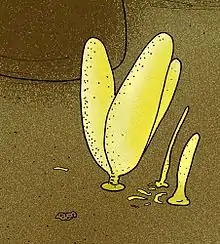| Tawuia Temporal range: | |
|---|---|
 | |
| reconstruction as a slime mold-like organism | |
| Scientific classification | |
| (unranked): | incertae sedis |
| Genus: | †Tawuia |
Tawuia is a millimetric disc-shaped, most likely multicellular macrofossil from the Neoproterozoic. It is considered to be synonymous with Chuaria and Longfengshania, which, in turn, are thought to represent different life stages of the same organism.[1]
Tawuia describes a more sausage- or crescent-shaped fossil; Chuaria refers to more discoial instances.
The fossils are often preserved as organic compressions. They are considered to represent microbial structures;[1] some authors consider them to be affiliated with slime molds[1] Stratigraphically, they range from 1,630 million years ago[2] to the late Ediacaran.[3]
Chuaria is multicellular.
References
- 1 2 3 Teyssèdre, B. (2003), "Trois classes de fossiles precambriens pour un meme taxon", Comptes Rendus Palevol (in French), 6 (503): 508–510, doi:10.1016/j.crpv.2003.09.023
- ↑ Srivastava, P.; Bali, R. (2006). "Proterozoic carbonaceous remains from the Chorhat Sandstone: oldest fossils of the Vindhyan Supergroup, Central India". Geobios. 39 (6): 873–878. doi:10.1016/j.geobios.2006.02.001.
- ↑ Grazhdankin, D. V.; Nagovitsin, K. E.; Maslov, A. V. (2007). "Late Vendian Miaohe-type ecological assemblage of the east European platform". Doklady Earth Sciences. 417 (1): 1183–1187. Bibcode:2007DokES.417.1183G. doi:10.1134/S1028334X07080107. S2CID 128473335.
This article is issued from Wikipedia. The text is licensed under Creative Commons - Attribution - Sharealike. Additional terms may apply for the media files.